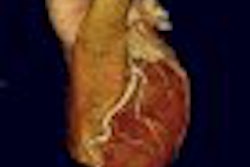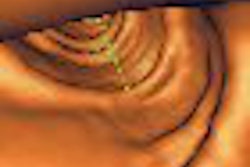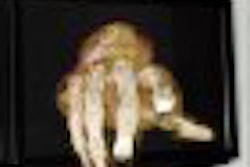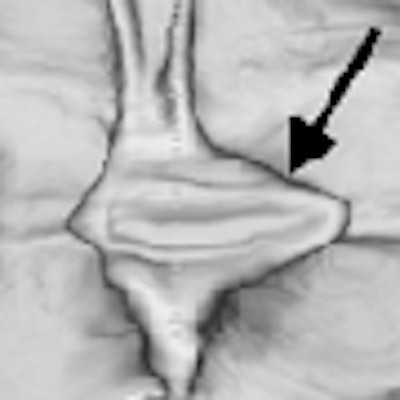
A virtual colonoscopy reading method that unrolls, opens, and displays the colon as a flat 3D model allowed readers in a recent study to find the same polyps they found in 2D or regular 3D endoluminal viewing, only faster. Still, double reading beat any single-display technique in lesion detection.
At the 2006 RSNA meeting in Chicago, Dr. Joel Fletcher from the Mayo Clinic in Rochester, MN, presented the findings from a study of 452 average-risk screening subjects who underwent VC followed by conventional colonoscopy as a reference standard.
"Several years ago we began a study looking at virtual dissection, in which the colon is straightened and then unzipped to display the endoluminal surface," Fletcher said.
The study employed an eight-detector-row scanner (LightSpeed Ultra, GE Healthcare, Chalfont St Giles, U.K.), no fecal tagging, and was performed between 2002 and 2004, he said.
Virtual Dissection (version 3.0, GE Healthcare) is a 3D-rendering software application that draws a midline trace through the colon and displays the entire luminal surface of the colon as a flattened 2D image.
Following a standard cathartic bowel prep and manual room-air insufflation, patients were scanned using a low-dose protocol at 50 mAs, 120 kVp, 0.5-sec rotation time, and 1.35 pitch.
"We had three radiologists, and each scan was interpreted by two of three readers," Fletcher said. "These three readers had a lot of experience in primary 2D and prospective VR (virtual reality) images, but only minimal performance of virtual dissection."
In all, Fletcher's group found 43 polyps that were 1 cm or larger in 38 patients, including 26 adenomatous polyps that were 1 cm or larger in 26 patients. At ROC analysis, the area under the curve (AUC) for readers 1, 2, and 3 for primary 2D interpretation was 0.88, 0.83, and 0.82, respectively. For primary 3D virtual dissection reads, the AUC was 0.69, 0.88, and 0.84 for the same readers, respectively.
"There was no significant difference in the AUC for the three readers for the two techniques," Fletcher said. Double reading was better than both, however. "The AUC increased to 0.97 when both 2D and 3D reads were done by different readers," he said.
The AUC for adenomatous lesions 1 cm and larger at primary 2D and primary 3D virtual dissection was 0.91, 0.84, and 0.88 versus 0.74, 0.91, and 0.91, respectively. Using double reading (utilizing a primary 2D plus a primary 3D virtual dissection interpretation by two different readers), the AUC increased to 0.97, Fletcher said.
"For adenomatous lesions 6-9 mm in size, there was no significant difference between readers 1 through 3 (AUC 0.71 to 0.98)," he said.
The sensitivity of same-day endoscopy was only 77%, and the technique found only 20 of 26 adenomatous lesions 1 cm and larger, Fletcher said.
"In terms of reading time, there was significant time savings from 14.5 to 10.5 minutes using primary 3D virtual dissection," he said.
There were four cancers, a tubulovillous adenoma, and a tubular adenoma, and both 2D and 3D virtual dissection found them all. They were all flat or polypoid lesions.
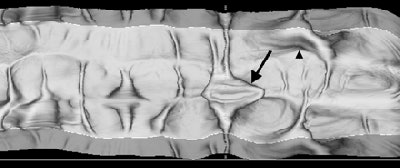 |
| Virtual Dissection (version 3.0, GE Healthcare) images of an 82-year-old man with ascending colon carcinoma seen at VC. Above, 360° virtual dissection image of right colon reveals lesion (arrow) that was considered to be a normal ileocecal valve. A 2.5-cm adenoma was found at colonoscopy. Normal valve can be identified in more proximal colon (arrowhead). Below, 3D endoluminal view shows colonoscopy-proven adenoma. Republished with permission of the American Journal of Roentgenology, from "CT colonography using 360-degree virtual dissection: A feasibility study," Johnson KT, Johnson CD, Fletcher JG, MacCarty RL, Summers RL, 2006 Jan;186(1):90-95. |
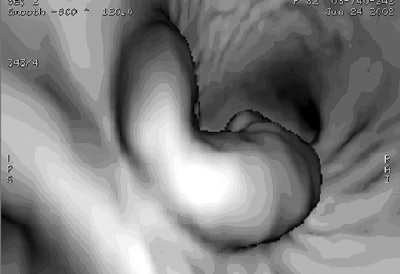 |
"The strengths of this technique are that it's endoluminal, it's shape-based," Fletcher said. "The image doesn't move, so it's like hanging up stockings on the sigmoid colon -- and some people find that distracting. Colonic segments can be read in groups so they read rather quickly. There is immediate interactivity between 3D and 2D."
A weakness of virtual dissection is the distortion, which can be daunting for inexperienced readers. "Particularly at the anus and cecum, where the centerline ends, it really requires 2D and 3D VR correspondence," Fletcher said.
Virtual dissection "performs similarly to 2D or 3D, allowing for time-efficient 3D review, and performs similarly to endoscopy for polyp and cancer detection in lesions 1 cm or greater in size," Fletcher concluded. "Double reading with primary 2D and 3D tended to improve our performance, and endoscopic miss rates can be highly variable."
Feasibility study
Earlier this year Mayo researchers led by Dr. Kristina Johnson, and Dr. Ronald Summers from the National Institutes of Health in Bethesda, MD, published a feasibility study using the same GE software on a colon phantom and in 20 patients. In addition to calculating sensitivity and specificity, they asked the readers to categorize the shape of longitudinal polyp distortions in the axial plane produced by the software into categories such as "flame" and "pea" (American Journal of Roentgenology, January 2006, Vol. 186:1, pp. 90-95).
Flat polyps were either flame- (31/47, 66%) or pea-shaped (16/47 34%), the authors reported. Pedunculated polyps were flame- (15/45, 33%), club- (20/45, 44%), or pea-shaped (6/45, 13%). The sensitivities of the three observers for polyps of 1 cm or larger were 94%, 82%, and 88%, with specificities of 100%, 100%, and 80%, respectively. In contrast to the study reported at RSNA, although double reading improved sensitivities slightly, the difference did not reach statistical significance.
"Although distortion of colonic structures exists at virtual dissection, it does so in recognizable patterns, so that sensitivity for polyp detection is not compromised," the group reported.
By Eric Barnes
AuntMinnie.com staff writer
December 12, 2006
Related Reading
VC visualization tool combines advanced features, August 17, 2006
2D primary reading plus CAD has an edge in VC study, July 11, 2006
VC software highlights colon's unseen areas, June 16, 2006
New VC reading schemes could solve old problems, October 13, 2005
'Filet view' VC software slices reading time, October 6, 2005
Copyright © 2006 AuntMinnie.com




